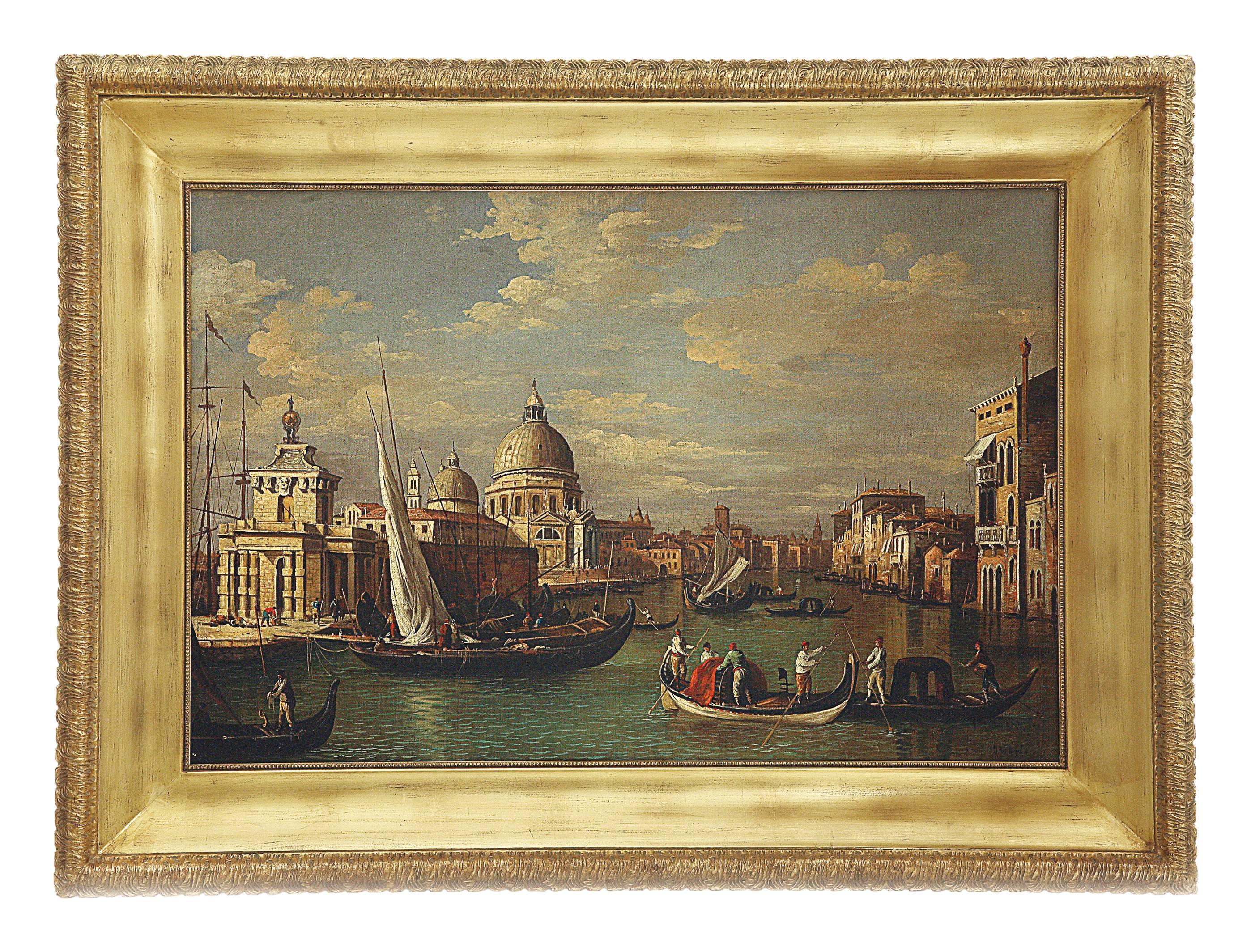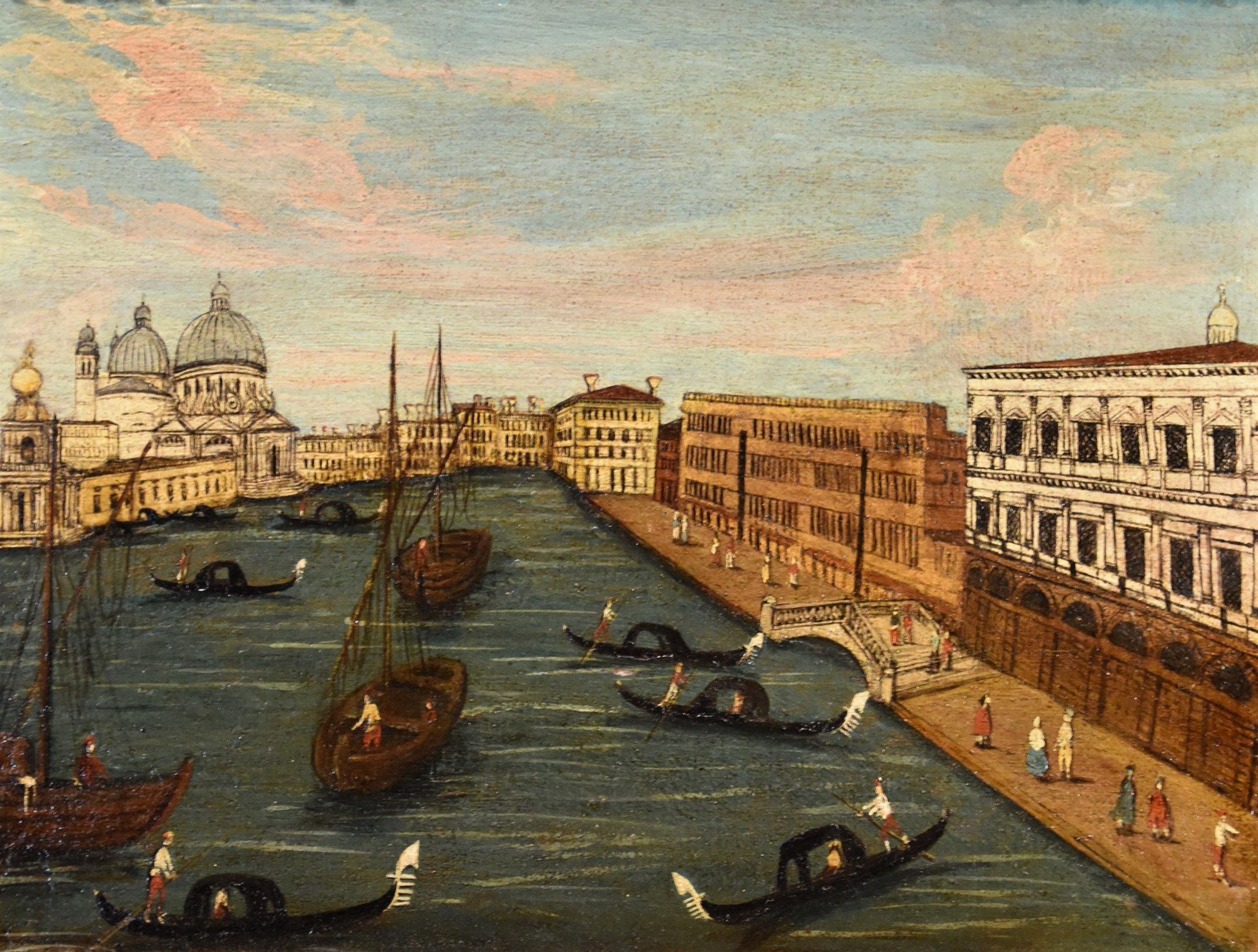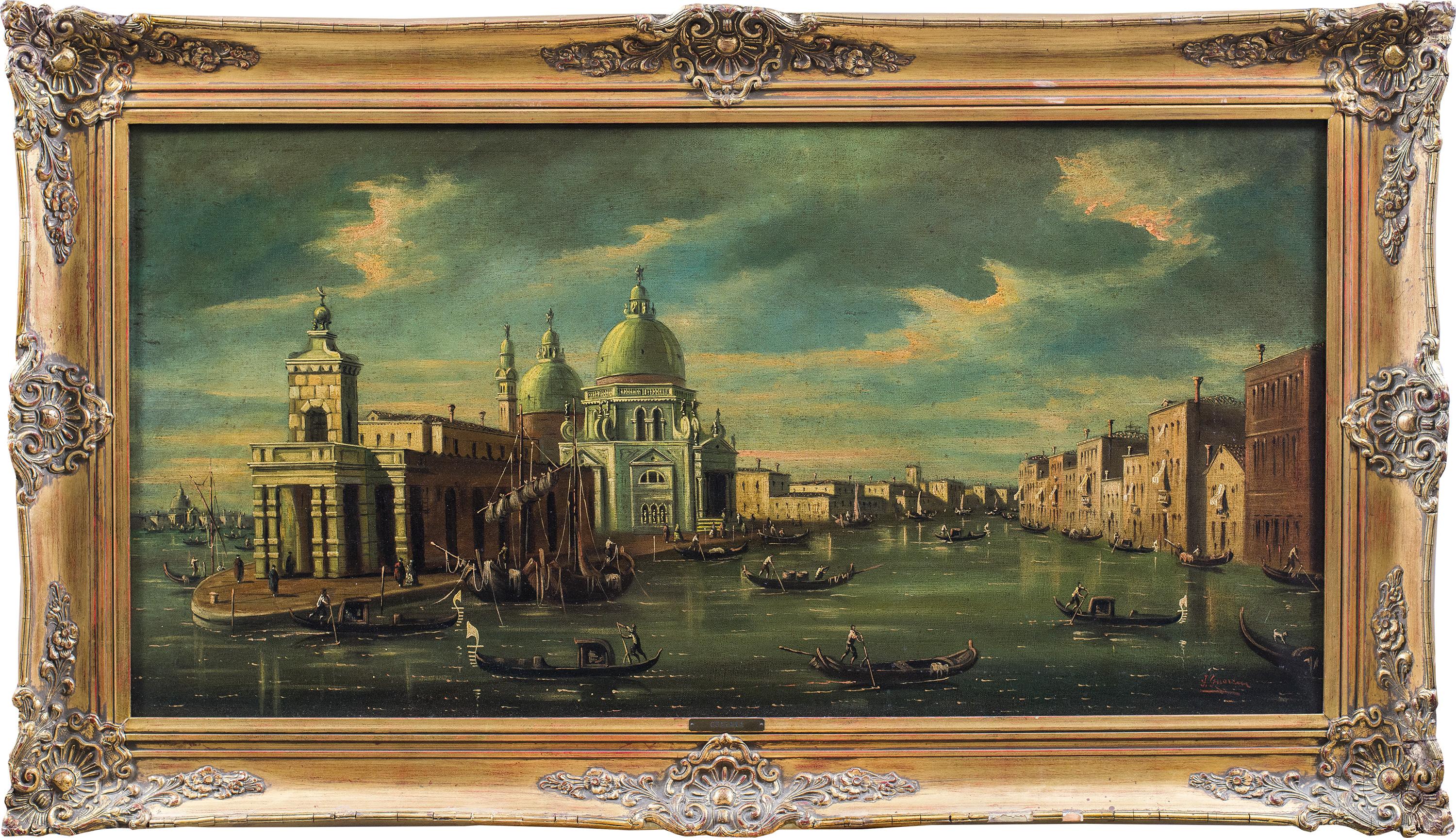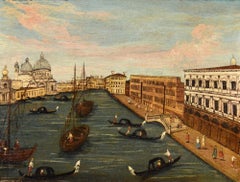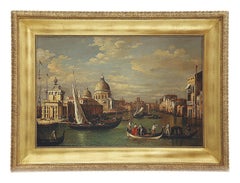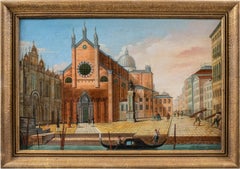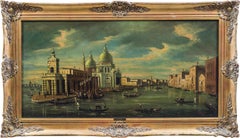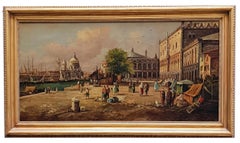Items Similar to Venice San Giorgio Marina Canaletto 19th Century Paint Oil on canvas Old master
Video Loading
Want more images or videos?
Request additional images or videos from the seller
1 of 13
Venice San Giorgio Marina Canaletto 19th Century Paint Oil on canvas Old master1800-1880
1800-1880
$4,604.84
$5,756.0520% Off
£3,472.89
£4,341.1120% Off
€3,952
€4,94020% Off
CA$6,366.59
CA$7,958.2420% Off
A$7,131.65
A$8,914.5720% Off
CHF 3,745.80
CHF 4,682.2520% Off
MX$86,718.62
MX$108,398.2720% Off
NOK 47,434.09
NOK 59,292.6120% Off
SEK 45,027.70
SEK 56,284.6320% Off
DKK 30,085.21
DKK 37,606.5120% Off
About the Item
View of Venice with the Island of San Giorgio Maggiore
Follower of Canaletto (Venice, 1697 – Venice, 1768)
Venice - 19th century
oil on canvas
29 x 39 cm. - Framed 40 x 50 cm.
Well executed, characterised by a palette of bright colours and a soft play of light and shade emphasised by a pleasant luminosity, the canvas - painted in the 19th century - is an interesting evocation of the refined Venetian vedutism.
It is a very interesting glimpse of Venice, a view of the island of San Giorgio Maggiore, located in front of St Mark's Square and bordered by the Giudecca Canal and the St Mark's Canal. In the centre stands the majestic facade of the Basilica of San Giorgio Maggiore, designed by Andrea Palladio, an essential element of the panorama that can be seen from St Mark's Square and in many paintings by landscape painters.
The painting, with its precise brushstrokes and the architecture defined in miniature with good veduta technique, is typical of the veduta production of artists who were inspired by the great Antonio Canal, known as Canaletto (1697-1768), the diamond tip of 18th century vedutism.
Works like ours, in particular, were produced in Venetian workshops in the 19th century, to satisfy collectors and refined travellers, especially English and German, but also French, who visited the city during their ‘Voyage d'Italie’, eager to possess an image of Venice in its most relaxed and characteristic dimension.
They were often commissioned in small sizes, to allow them to be transported with luggage, while now these small ‘postcards’ have become highly sought after and appreciated by modern collectors.
ADDITIONAL INFORMATION:
The work is sold complete with a pleasant gilded wooden frame and is accompanied by a certificate of authenticity and an iconographic descriptive sheet.
We take care of and organise the transport of the purchased works, both in Italy and abroad, through professional and insured carriers.
It is also possible to view the painting in the gallery in Riva del Garda, we will be happy to welcome you and show you our collection of works.
In the event of the work being purchased by a non-Italian client, it will be necessary to obtain an export permit, which takes approximately 10/20 days; our gallery will take care of the entire process until the permit is obtained. All the costs of this procedure are included.
Please feel free to contact us for any further information.
- Creation Year:1800-1880
- Dimensions:Height: 15.75 in (40 cm)Width: 19.69 in (50 cm)
- Medium:
- Movement & Style:
- After:Canaletto (Venice, 1697 – 1768)
- Period:
- Condition:
- Gallery Location:Riva del Garda, IT
- Reference Number:1stDibs: LU988115773442
About the Seller
4.9
Platinum Seller
Premium sellers with a 4.7+ rating and 24-hour response times
Established in 2017
1stDibs seller since 2018
255 sales on 1stDibs
Typical response time: <1 hour
- ShippingRetrieving quote...Shipping from: Riva del Garda, Italy
- Return Policy
Authenticity Guarantee
In the unlikely event there’s an issue with an item’s authenticity, contact us within 1 year for a full refund. DetailsMoney-Back Guarantee
If your item is not as described, is damaged in transit, or does not arrive, contact us within 7 days for a full refund. Details24-Hour Cancellation
You have a 24-hour grace period in which to reconsider your purchase, with no questions asked.Vetted Professional Sellers
Our world-class sellers must adhere to strict standards for service and quality, maintaining the integrity of our listings.Price-Match Guarantee
If you find that a seller listed the same item for a lower price elsewhere, we’ll match it.Trusted Global Delivery
Our best-in-class carrier network provides specialized shipping options worldwide, including custom delivery.More From This Seller
View AllView Venice See Giudecca Guardi 18/19th Century Paint Oil on canvas Old master
Located in Riva del Garda, IT
Giacomo Guardi (Venice, 1764 - Venice, 1835)
View of Venice with the Giudecca Canal and the Gesuati Church
oil on canvas
34 x 42 cm. - framed 40 x 50 cm.
Expertise dott Federica Sp...
Category
18th Century Old Masters Paintings
Materials
Oil
$15,147 Sale Price
20% Off
View Venice Grand Canal See Landscape 18th Century Paint Oil on canvas Venice
Located in Riva del Garda, IT
Vedutist painter of the 18th century
View of Venice with the Grand Canal, the Punta della Dogana with the Basilica of Santa Maria della Salute on the left, the Palazzo Della Zecca wi...
Category
18th Century Old Masters Paintings
Materials
Oil
Venice See Landscape Bella 18th Century Paint Oil on canvas Old master Italy
Located in Riva del Garda, IT
Gabriele Bella (Venice 1730 – Venice 1799) attributed
View of Venice with the Guglie bridge (or the Cannaregio bridge, as it was formerly called) circa 1750/60
oil on canvas, ...
Category
18th Century Old Masters Paintings
Materials
Oil
$10,663 Sale Price
20% Off
VeniceSee Water Landscape Marina Heilmaier 19th Century Paint Oil on canvas Art
Located in Riva del Garda, IT
Maximilian Heilmaier (1869 Isen - 1923 München)
Signed Max Heilmaier Munchen bottom left
Venice with St. Mark's Square and the Doge's Palace from the Lagoon ( - LINK -)
Oil on canv...
Category
19th Century Expressionist Paintings
Materials
Oil
$5,453 Sale Price
20% Off
Venice Grand Canal Landscape Bouvard Aldine 19/20th Century Paint Oil on canvas
Located in Riva del Garda, IT
Antoine Bouvard, called Marc Aldine (L'Isere 1875 - Paris 1957)
Signed 'Bouvard' lower right
View of Venice with the Grand Canal (link)
oil on canvas
60 x 86 cm
Framed 70 x 96 cm.
Very good condition
We present an evocative view of Venice with a glimpse of the fascinating Grand Canal, signed by the famous French Vedutist Antoine Bouvard, also known by his pseudonym, Marc Aldine.
Considered one of the most talented illustrators of the lagoon city who worked there in the first part of the 20th century, he became one of the most acclaimed vedutists of that period, with a success that led him to exhibit throughout France and Italy as well as in numerous European galleries...
Category
19th Century Expressionist Paintings
Materials
Oil
$7,028 Sale Price
20% Off
Landscape See Paint Oil on canvas Flemish Old master 18th Century Italian Art
Located in Riva del Garda, IT
Flemish painter active in Italy in the eighteenth century
Coastal landscape of the Mediterranean with architectures and figures
Oil painting on canvas (69 x 88 cm., in frame 80 x 100 cm.)
The suggestive view proposed depicts a coastal view with a bay and the ruins of an ancient building, probably a monastery or a church, and in the background another building with a garden surrounded by high walls close to the shore.
The type of landscape, typical of the southern Italian environment, and the intimate atmosphere that welcomes the scene, attributes the authorship of the work to a landscape painter active in the eighteenth century, presumably in Italy in this period, with immediate references to the Dutch school , and in particular to the production of Jacob de Heusch and above all of Gaspar van Wittel, considered the progenitor of Italian landscape painting.
In fact, in the rendering of the architectural details, in the purity with which the buildings have been reconstructed, as well as in the atmosphere that encompasses the entire landscape, a marked correspondence to the so-called "Vanvitellian realism" can be seen: in fact, a comparison with a certain series of views which the Dutchman...
Category
18th Century Old Masters Paintings
Materials
Oil
$6,907 Sale Price
20% Off
You May Also Like
VENICE -In the Manner of Canaletto- Italian Landscape Oil on Canvas Painting
By Mario De Angeli
Located in Napoli, IT
Venice - Mario De Angeli - Italia 2009 - Oil on canvas cm. 80x120.
Gold leaf gilded wooden frame ext. mis. cm.100x140
Mario De Angeli's canvas is an extraordinary work of Italian l...
Category
Early 2000s Old Masters Landscape Paintings
Materials
Gold Leaf
Vedutist Venetian painter - 19th century landscape painting - Venice view
Located in Varmo, IT
Venetian painter (19th century) - Venice, view of Campo Santi Giovanni e Paolo.
40 x 63 cm without frame, 49 x 70.5 cm with frame.
Antique oil painting on canvas, in an antique gil...
Category
Mid-19th Century Realist Landscape Paintings
Materials
Canvas, Oil
$2,563 Sale Price
51% Off
Free Shipping
Francesco Guarana (Venetian) - 19th/20th century landscape painting - Venice
Located in Varmo, IT
Francesco Guarana (active in Venice in the second half of the 19th century) - Venice, view of the beginning of the Grand Canal with the Basilica of S. Maria ...
Category
Late 19th Century Realist Landscape Paintings
Materials
Canvas, Oil
VENICE-In the Manner of Canaletto - Italian Landscape Oil on Canvas Painting
By Mario De Angeli
Located in Napoli, IT
Venice - Mario De Angeli - Italia 2008 - Oil on canvas cm. 60x120.
Mario De Angeli's canvas is an extraordinary work of Italian landscape painting.
They are inspired by the landsc...
Category
Early 2000s Italian School Landscape Paintings
Materials
Gold Leaf
VENICE - In the Manner of Canaletto -Italian Landscape Oil on Canvas Painting
By Mario De Angeli
Located in Napoli, IT
Venice - Mario De Angeli - Italia 2008 - Oil on canvas cm. 75x150.
Mario De Angeli's canvas is an extraordinary work of Italian landscape painting.
They are inspired by the landsc...
Category
Early 2000s Italian School Landscape Paintings
Materials
Gold Leaf
VENICE - In the Manner of Canaletto -Italian Landscape Oil on Canvas Painting
By Mario De Angeli
Located in Napoli, IT
Venice - Mario De Angeli - Italia 2006 - Oil on canvas cm. 70x90.
Mario De Angeli's canvas is an extraordinary work of Italian landscape painting. They are inspired by the landscap...
Category
Early 2000s Old Masters Landscape Paintings
Materials
Canvas, Oil
More Ways To Browse
Old Master Painting French
French 19th Century Masters
View Of Venice
German Old Masters
Venice Italy Oil Painting
Antique View Master
Antique Venice Painting
Paintings Of Marina
Old Masters Venice
Italian View Of Venice Painting
19th Century Venice Painting
Old Masters Paintings Of Venice
Venetian Painters
German 19th Century Oil Canvas
Oil Painting 1800
France Postcard
Painting Of Venice Canals
18th And 19th Century Oil Paintings
